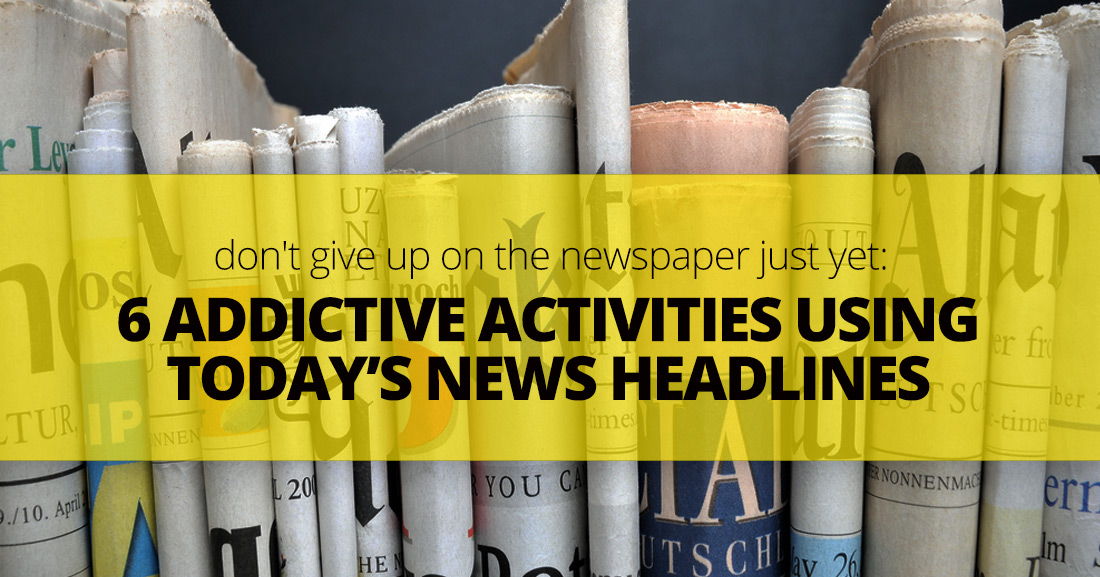7 Great Ways to Get the Most out of That Newspaper Report


Even if you are like me and never read the newspaper, you can still put it to good use in your ESL classroom. Here I’ve put together six great activities you can do using today’s newspaper. Not only will your students get a great language workout with these activities, they will have a great time and get some hands on language practice. So get ready for a special delivery in your classroom today.
In this simple reading comprehension activity, students will read headlines from recent news stories and match them to the correct article they title. Make the activity a little more interesting by giving each student an envelope which holds one copy of each of five to ten news article headlines. Then post the actual articles around your room on bulletin boards or tape them up on your walls. Students move around the room and read the articles. They then post their copy of what they think is the correct headline above the article (using pushpins or tape). If you like, have each person start on a different article and let them move either direction once they are done to make sure no one just copies the answers from another classmate. When students have posted all of their titles over the correct articles, have them sit down and talk about which headlines actually went to which articles. Acknowledge anyone who got all of their titles on the correct articles.
Are you familiar with the satirical newspaper The Onion? They print humorous stories related to real current events. You can use some of their articles in this fun activity with your class which challenges your students’ abilities to tell the difference between truth and fiction. Gather up to ten articles with their headlines. Make sure some of the articles are truthful news articles from reputable sources and others are fictional stories from the Onion or other news sources (E.g. The Inquirer). Copy all of the headlines on a sheet of paper in random order and have groups of two or three students work together to decide if each headline goes with a true article or a false one with only the headlines as their source of information. Once students have made their guesses, give them copies of the actual articles to read. As they read, students should be able to tell whether their guesses were correct. Wrap up the activity by confirming with your class which articles were true and which were false. Invite students to share why they thought each was true or false, and you can point out some clues in the article that would have helped them make the correct guess.
Newspaper headlines can present a real challenge to nonnative speakers. They are filled with unusual words, atypical grammar, and even puns. You can use today’s headlines as a way to teach your students some less than common vocabulary. Give students an article with one or more words in the headline underlined. You will want to choose words that don’t naturally fall within your ESL students’ experience. Students should read those words and guess at their meaning based on their context in the headline. Then they should read the article and see if they can find one or more synonyms for the underlined words in the text of the article. Wrap up the activity with your entire class by looking up each unusual word in a thesaurus and finding some more common synonyms that could be used in its place.
Everyone loves a scavenger hunt, am I right? Well you can have one in your classroom, and your students won’t even be bumping into each other as they search for the items on the list. That’s because this scavenger hunt happens in a newspaper. Divide your class into teams of three or four students each. Then give each group a copy of the same newspaper. Along with the newspaper, give them a list of things they need to find in the paper. You can use this printable or another. There are tons available for free online. If you want to have more control over what your student are looking for in the paper, write up your own items for students to search out. You might consider including certain vocabulary words or grammar structures on your list. Students will then work together to find all of the items on the list in the paper they were given. Students should write down their answers or circle the items in the actual paper. Wrap up the activity by letting students share some interesting facts they found in their newspapers. Finally have a class discussion about whether newspapers are still of value in today’s digital world.
Have you notices that article headlines often aren’t in complete sentences? In this activity, you will challenge your students to take ungrammatical headlines and rewrite them as complete sentences. Give students a list of ten to twenty headlines that are not grammatical. They can be from any source including one or more of the previous activities you have already done in class. Ask students to work on their own to rewrite each headline as a complete sentence. As they write, students should take note of which words are frequently left out of headlines. Then have students work with a partner to check their rewritten headlines for any grammar errors before you go over what each headline was missing in a class discussion. Ask volunteers to share how they rewrote each headline to make it a grammatical sentence.
In this activity, students will take a written text and use it as the basis for a speaking activity. Match each student to a partner. Give one person five headlines (labeled one through five) and the other person the five articles (labeled A through E) that go with those headlines. Students are not allowed to read what their partners have nor are they allowed to read their items out loud to their partner. Each person should read the items on their own paper then talk together to try and match each headline to the correct article. Students can rephrase what is on their papers, but they cannot read directly from the paper. So students with the headlines will have to be particularly careful about reading their papers to their partner. Once students think they have correctly matched their headlines to their articles, have them check their answers with you. Tell them how many matches out of the five articles they have. If the pair has less than five matches, they must return to their desks and discuss their headlines and articles again, trying to locate their error(s). Have students work together until they are able to match each headline to its correct partner.
A ton of fun and opportunity for learning for your ESL students. And that, after all, is very good news.